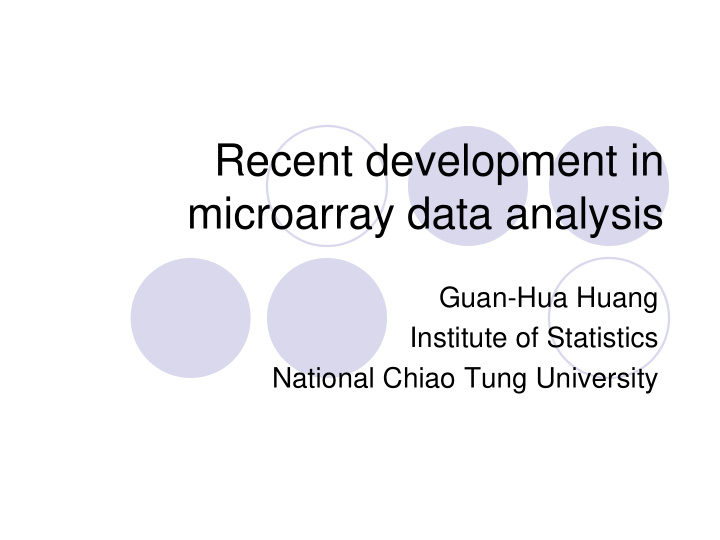



Recent development in microarray data analysis Guan-Hua Huang Institute of Statistics National Chiao Tung University
Gene expression microarray The overwhelming majority of results rely on measures of relative expression -- genes are reported to be differentially expressed Has not yet led to big advances in diagnosis or treatment The main reason: Probe characteristics can cloud the relationship between observed intensity and actual expression Although this “probe effect” is large, it is also very consistent across different hybridizations Relative measures of expression are substantially more useful than absolute ones.
A gene expression bar code for microarray data (Zilliox & Irizarry. Nature Methods 2007) Accurately demarcate expressed from unexpressed genes Select cutoff points for each platform and for each gene Use the vast amount of publicly available data sets (GEO, ArrayExpress) to select cutoff points Found that the probe effects are not large enough to change the expressed/unexpressed calls that form the bar code, making this new procedure robust to the lab/batch effects.
A gene expression bar code: for Affymetrix HGU133A chips 1. Obtain all the control samples for which the raw data (CEL files) were available from GEO and ArrayExpress 2. All raw data were preprocessed using RMA. 3. For each gene, select the cutoff point for expressed/unexpressed. 4. If a new sample is provided, simply compare the observed intensity to the determined cutoff point for each gene to determine its expressed/unexpressed – the gene expression bar code
Bar code cutoff point selection Any given gene will only be expressed in some tissues, multiple modes should be observed. The lowest intensity mode is due to a lack of expression.
Classification performance
Describe a framework for accurately and robustly resolving whether individuals are in a complex genomic DNA mixture using high- density SNP genotyping microarrays.
Determination criteria - relative differences Use raw allele intensity measures to estimate allele frequency, not the qualitative genotype The distance measure = − − − ( ) | | | | D Y Y Pop Y M ij ij j ij j Y ij : the allele frequency estimate for the individual i and SNP j M j : the allele frequency of the mixture at SNP j Pop j : the reference population’s allele frequency
Hypothesis testing H 0 : the individual is not in the mixture H 1 : the individual is in the mixture Under H 0 , D ( Y ij ) ≦ 0 Under H 1 , D ( Y ij ) > 0 Test statistic : one sample t test ( ) H mean D 0 ~ ( 0 , 1 ) Normal ( ) / sd D n
Bar code vs. resolving complex mixtures To overcome microarray probe effects Bar code – for each gene to determine its expressed/unexpressed Resolving complex mixtures – for each gene to calculate the difference between the individual and the reference relative to the difference between the individual and the mixture
Possible research topics ALE strata for subdividing a microarray dataset and analyze each stratum individually with the best performing methods Use public available datasets (GEO, ArrayExpress) to generate the “norm” for microarray analysis Use public available datasets (GEO, ArrayExpress) and bar code idea to simulate “real” microarray data
Tailor-made, small-market arrays to suit more specific research needs Improvements designed to drive prices down and expand into clinical diagnostics. creating arrays that can be used to isolate specific regions of the genome for sequencing -- ‘capture arrays’
Recommend
More recommend